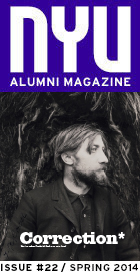alumni profile
The Face of Hope
Eduardo D. Rodriguez / DEN ’92
by Jo Kadlecek
On any given day, you can find Eduardo D. Rodriguez sketching. Pen in hand, he outlines faces, shades in features, and delineates bone structures. He doesn’t consider himself an expert, but his love for drawing serves two purposes: It keeps his hands nimble, and it prepares him for surgeries that require an artist’s eye and attention to detail.“Most surgeons who know me know that I mark and design very carefully how we’ll be performing an operation,” he says. “I’m a rookie sketcher, but it helps me understand what I’m going to do, giving me complete clarity.”
Rodriguez is no rookie, though, when it comes to the operating room. As the new chair of the department of plastic surgery at NYU Langone Medical Center, he is recognized around the world for his leadership in reconstructive and craniofacial plastic surgery. His creative vision, compassionate approach, and extensive experience have helped hundreds of disfigured patients return to normal lives.
One patient recently made medical history with Rodriguez. In 1997, a gun accident severely damaged 22-year-old Richard Norris’s jaw, lips, teeth, tongue, and nose. Numerous conventional reconstructive surgeries had done little to help the physical and emotional pain caused by the Virginia native’s deformity. He avoided most personal interaction; when he did venture into public, it was after dark, and he wore a mask and hat.
In 2005, Norris met Rodriguez, who spent the next six years imagining, researching, designing, and planning the unprecedented possibility of a complete face transplant. Though partial facial transplants have been performed for almost a decade, with relative success (out of 28 performed, four patients have died), both Rodriguez and Norris knew that their breakthrough surgery would be far riskier.
But when news of an organ donor arrived, neither hesitated. Overseeing a team of five surgeons and 150 medical experts, Rodriguez performed the most comprehensive full-face transplant in history at the University of Maryland Medical Center in March 2012. It took 36 hours, but Norris couldn’t be happier with the results. Now instead of gawkers, “there’s no one paying attention,” he says. “Unless they know me personally, they don’t know I am a face transplant patient. That right there is the goal we had.”
The surgery promises significant hope that people like Norris can also rebuild their lives. Such opportunities, Rodriguez says, will only expand at NYU Langone. In fact, since arriving in New York last November—which Rodriguez says felt like “coming home”—he and his translational research staff have already begun partnering with outside agencies to expedite the organ donor process. And because of NYU’s well-defined progression of care and research in tissue transplantation and regeneration, Rodriguez says the innovative tools that exist here can take them to new frontiers in educating doctors around the globe. Surgical simulations, coupled with a network of computers and remote controls, allow medical training to have a wider reach. “We can teach a surgeon in another part of the world to perform facial reconstruction,” he says.
Even with such great medical possibilities in front of him, at the end of the day, Rodriguez sees the art of caring as his primary focus. “I love to take care of people. Patients and families give me much more than I could ever give them. They come in with really complex problems, and I have to tell them that it’s going to get worse before it gets better,” he says. “But I make the commitment that I’ll be with them every step of the way, however bitter it may be. Are there ups and downs? Of course. But I find more ups than downs.”





